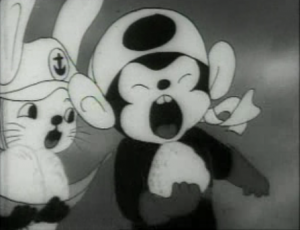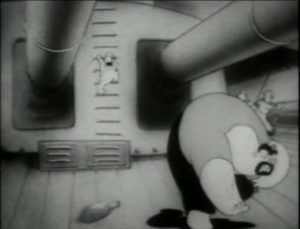Animation is a powerful medium that is a very effective way of portraying certain ideologies to young children. In Japan, the character Momotarō takes on the role of a young hero which appeals to the adventurous side of children. Momotarō’s antics and quests capture the hearts of Japanese children from a very young age starting with the folklore of the boy born from a peach to recent adaptations of the fairy tale. Creating a tool of propaganda, Mitsuyo Seo creates the movie Momotarō’s Sea eagle, an anime that is purposed to fill children with national pride during World War II. Through the use of the youthful affections of Momotarō, Seo is able to ignite a sense of patriotism in Japanese youth with a new spin on an old story.
In this anime, Momotarō commands an army of animals against the demons of “Demon Island.” This animal army is animated with plump, cute faces and they are shown scampering innocently aboard a battleship. They playfully set up machines of war and even poke fun at each other as they prepare for an attack. For children, this kind of activity is fun to watch and it downplays the gravity of battle that looms about the story.
The plot line is easily accepted as the severity of war is softened and the innocence of the animals takes its place. In addition, this depiction of the army makes it very easy to feel pride in the nation in which it represents. Not only do they appear cute, but they perform amazing tasks during battle that are extremely desirable to a young viewer. In much the same way a superhero inspires an American child, this anime creates a want for children to emulate Momotarō’s army, effectively instilling national pride in the process.
The army itself isn’t the only part of the anime that appears playful. The attack on Demon Island by the Japanese army is more of a game than it is a battle. This depiction of battle is intended to divert children’s attention away from death and towards a joyful victory. At no point in the film does a bullet kill an enemy (or an animal for that matter), and explosions do little damage besides comically sinking ships.
The enemy of Demon Island runs about frantically, tripping and lumbering about. They are depicted this way in order to make them come across as inferior, as if they deserve to be ridiculed by the animal army. This is very effective when it comes to a child audience, due to the fact that instead of being killed the enemy is only being bullied. The young viewers can relate to this concept easier than to the actual nature of war.
Seo was successful in creating a movie that involves the ideas of war while still affecting Japanese youth with the ideology of national pride. It is important to note the subtle ways in which he is able to instill the ideas of war and Japanese victory into a child’s mind without subjecting it to the gruesome consequence of death.



